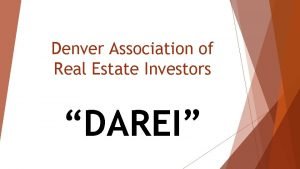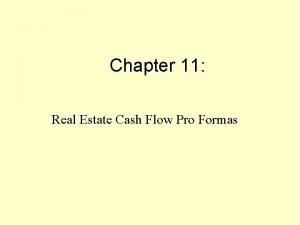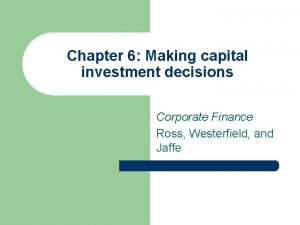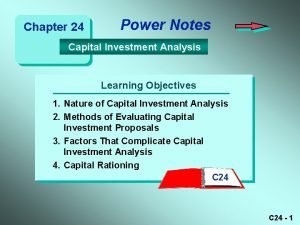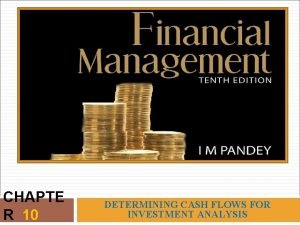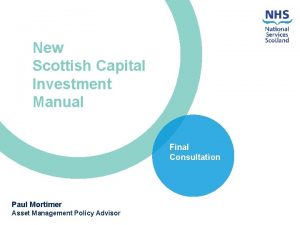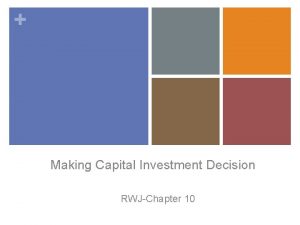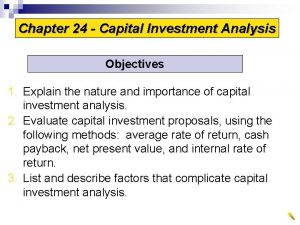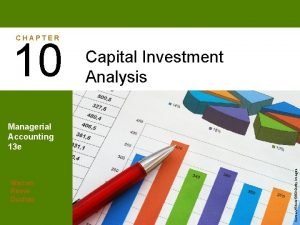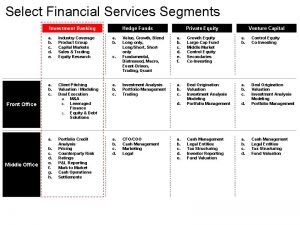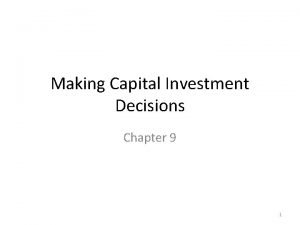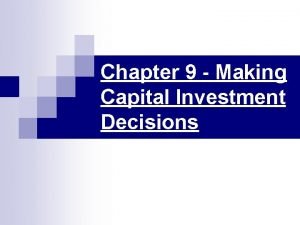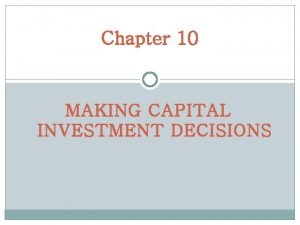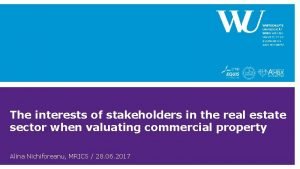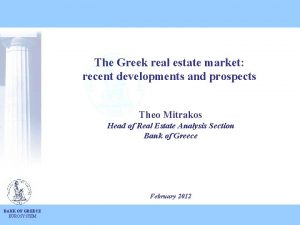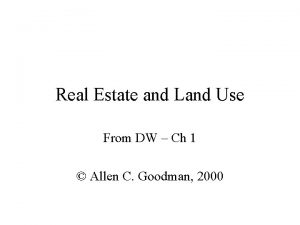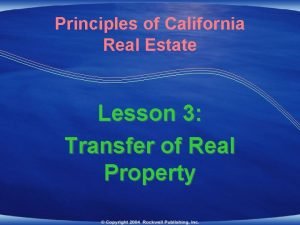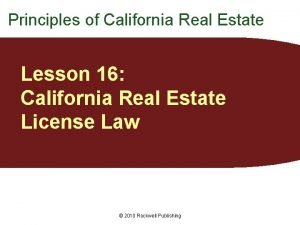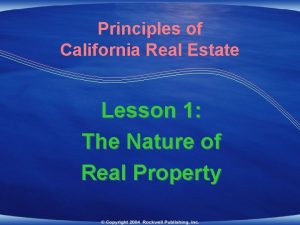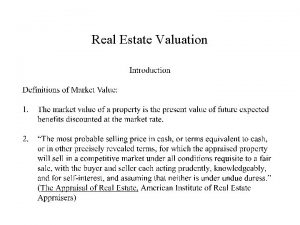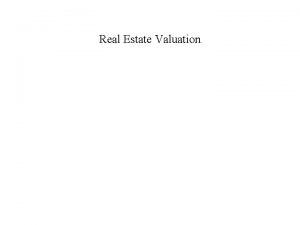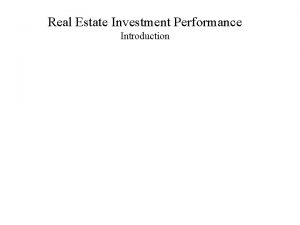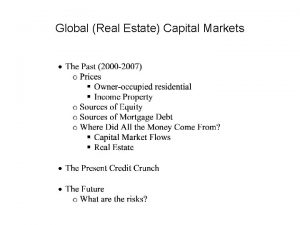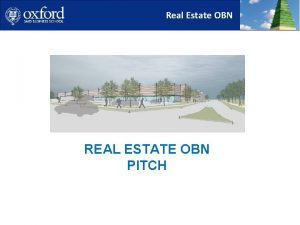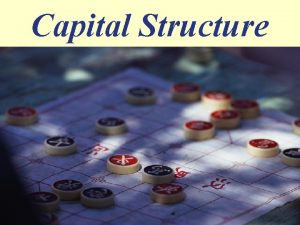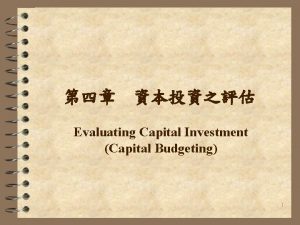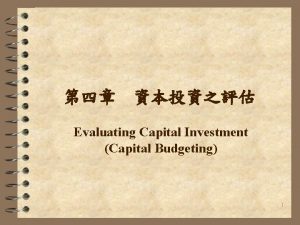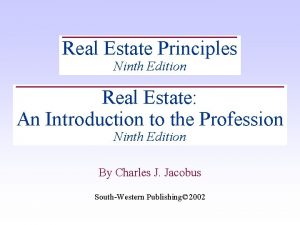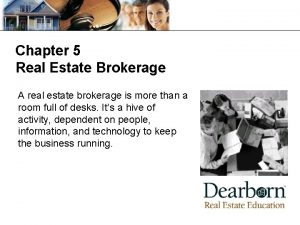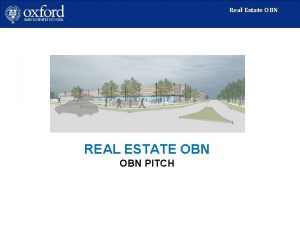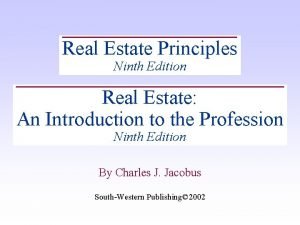REAL ESTATE INVESTMENT CAPITAL STRUCTURE 2014 On Course


































- Slides: 34

REAL ESTATE INVESTMENT CAPITAL STRUCTURE © 2014 On. Course Learning. All Rights Reserved. Chapter 15 1

CHAPTER OUTLINE 15. 1. 1 Debt to Obtain Positive Equity NPV 15. 1. 2 Debt and Diversification 15. 1. 3 Limitations on the Equity Constraint Argument for the Use of Debt 15. 2 Other Considerations Regarding the Role of Debt in Real Estate Investments 15. 2. 1 15. 2. 2 15. 2. 3 15. 2. 4 Debt as an Incentive and Disciplinary Tool for Management Debt and Liquidity Cost of Financial Distress Debt and Inflation 15. 3 Project-Level Capital Structure in Real Estate 15. 3. 1 Enriching the Traditional Capital Structure Plate 15. 3. 2 Numerical Example of Multi-Tiered Project Capital Structure 15. 3. 3 Analyzing Project-Level Capital Structure: An Example Application of Sensitivity Analysis © 2014 On. Course Learning. All Rights Reserved. 15. 1 Debt When There Is an Equity Capital Constraint 15. 4 Chapter Summary 2

After reading this chapter, you should understand: ➲ What is meant by capital structure and the major pros and cons for the use of debt financing of real estate equity investments for different types of investors. ➲ What is meant by an equity capital constraint and how this can affect the value of debt financing. ➲ The relationship between the use of debt financing and such considerations as management incentives, investor liquidity, and inflation. ➲ The costs of financial distress and how these are affected by the use of debt. ➲ Typical capital structures used in micro-level real estate investment (project-level financing). © 2014 On. Course Learning. All Rights Reserved. LEARNING OBJECTIVES 3

“Capital Structure” = Use of debt vs equity (how much of each) as sources of financial capital. Traditionally this question has focused on publiclytraded corporations, but… • Much real estate investment is made more directly, not through publicly-traded companies. • Much real estate investment is financed at the project level (individual assets are financed directly). © 2014 On. Course Learning. All Rights Reserved. = How investment (asset ownership) is financed. . . • Real estate assets trade directly, and are relatively simple, transparent cash generators. 4

In theory, publicly-traded corporations never face an equity capital constraint (if the stock market is efficient). Whenever they face a positive-NPV investment opportunity, they can simply issue new stock to obtain equity financing. This is not the case for private companies or individuals. Nor for tax-exempt institutions such as pension funds. In real estate investment, debt finance can be useful simply as a NECESSARY source of capital if you face an equity constraint, and: 1. You face a positive (or at least non-negative) NPV opportunity (at least from IV perspective), or © 2014 On. Course Learning. All Rights Reserved. 15. 1 Debt When There is an Equity Capital Constraint 2. You seek more diversification across properties than your equity alone can allow, given the size of properties and the amount of your equity. 5

Use debt financing to leverage your “human capital” (as well as your financial capital: • Your skill and talent and knowledge enable you to successfully manage income property. • This enables you to earn “wages” or “profits” effectively as a “property manager” or “asset manager”. • The more properties you own, the more you can guarantee yourself a job managing, hence, the more earnings you can make on your managerial human capital. • Use of debt allows you to own more properties, to extend your human capital earnings. © 2014 On. Course Learning. All Rights Reserved. A particular point for small-scale individual entrepreneurs: (How else could you possibly cash in on such human capital without taking on the financial investment role as well? . . . ) 6

• Define multiple “profit centers” for the firm, some of which derive from operations as distinct from passive investment. • “Operating expenses” that are pure cash outflows from the investment perspective, may contain an element of profit from the operational perspective. Thus, a deal contains more than one source of value: • NPV from the pure investment perspective (return on financial capital). • NPV from operational profit centers (return on human capital). • Together the two (or more) NPVs above equal the total NPV of the deal from the firm’s (or individual’s) particular IV (“investment value”) perspective (see Ch. 12). © 2014 On. Course Learning. All Rights Reserved. How would the leveraging of human capital show up in the quantitative DCF and NPV mechanics we described in previous chapters? . . . 15. 1. 3: Beware: constraints on equity capital availability may not be as great or as binding as you first might think. There are lots of ways to “joint venture” in real estate deals. 7

Debt as an Incentive and Disciplinary Tool for Management © 2014 On. Course Learning. All Rights Reserved. 15. 2. 1 8

© 2014 On. Course Learning. All Rights Reserved. 15. 2. 2 Debt and Liquidity 9

© 2014 On. Course Learning. All Rights Reserved. 15. 2. 3 Cost of Financial Distress 10

© 2014 On. Course Learning. All Rights Reserved. Exhibit 15 -1: Cost of Financial Distress 11

© 2014 On. Course Learning. All Rights Reserved. 15. 2. 4 Debt and Inflation 12

© 2014 On. Course Learning. All Rights Reserved. Exhibit 15 -2: Example of effect of inflation on ex-post levered equity appreciation returns with 1 -year loan. . . 13

15. 3 Much real estate finance occurs at the micro-level of individual investments in properties, projects, or “deals. " Hence, much “capital structure” in real estate occurs at this micro-level. Why? . . . • Much real estate investment is still done directly by individuals or small entrepreneurial firms. • Also real estate assets are relatively simple, tangible and “transparent”: Makes them ideal candidates for secured debt and other types of projectlevel financing © 2014 On. Course Learning. All Rights Reserved. Project Level Capital Structure in Real Estate • (External investors need to feel confident that they know what is going on in the investment even if they don’t have direct management control or highly specialized expertise. ) • Also, the law governing real property rights facilitates this type of finance. 14

General points: Just because finance is at the project (asset) level does not alter the basic principles and considerations presented in Chs 13 -15. © 2014 On. Course Learning. All Rights Reserved. Classical micro-level real estate finance consists of equity and debt (mortgage): • Chs 13 & 14, & Sects 15. 1 & 15. 2 apply. In recent years, capital markets have become more sophisticated. More types of investment vehicles tailored to a more diverse range of investors. Result is growth in more complex capital structures at the microlevel. (Ways & means to get more leverage! Hence: Watch out!) Consider some of the new, additional types of financing and capital structures being used for real estate investments in the U. S. today. . . Two major purposes of these “fancier” structures (same as traditional): 1. 2. Match risk & return (& CF timing & liquidity) preferences to Esp for multi-layer project finance. heterogeneous investors Provide appropriate performance incentives to parties controlling the underlying physical capital (the real estate). Esp for JV splits. 15

Multi-layer project finance… 1 st-lien mortgage (senior debt investment) is split into two or more separate notes. Allows separate investors or owners of the same mortgage. Splitting may be done either “horizontally” or “vertically” (or both). With horizontal splitting the two notes are identical in terms of seniority and interest (“pari passu”). Sometimes one note will be securitized and the other held privately, or the two notes will both be securitized but into different CMBS pools (as the entire loan might be too large for any one pool). With vertical splitting there may be an “A” note and a “B” note, with “A” having senior claim to cash flow or collateral. In effect, the Bnote becomes much like a “second mortgage” or subordinate debt, though it is structured as a note on a single underlying mortgage. Sometimes the A-note will be securitized and the B-note held privately. © 2014 On. Course Learning. All Rights Reserved. Multiple-Note 1 st-lien Mortgage From equity investors’ perspective, the whole thing is just like one senior debt obligation. 16

Multi-layer project finance… So-called “mez debt” is an investment vehicle structured as a loan, may include a “lien” on the underlying property, but often unsecured to operating entity, in any case subordinated to other specified senior investment vehicles (such as 1 st-lien mortg), but mez is senior to equity. Mez debt investors typically don’t receive return on or of their investment until after senior debt holders are fully compensated for what is owed them. Mez debt capital is typically “drawn” or placed into the investment before the senior debt capital. Mez debt thus provides a buffer of capital exposure helping to protect the senior debt investors. © 2014 On. Course Learning. All Rights Reserved. Mezzanine Debt Mez debt typically carries interest rates considerably above those of first mortgages. Similar to CMBS “B piece” only not based on diversified pool of mortgages but rather on single property asset collateral. 17

Multi-layer project finance… Preferred Equity But normally subordinated to any secured debt on the property and any mez debt to the operating entity. May be a 3 rd layer (out of 4). Generally does not include formal collateral or lien on the underlying real estate. Preferred equity senior to common equity in priority of claims. Preferred equity obtains its returns usually purely in the form of a preferred dividend (no appreciation of principle or capital paid in). Sometimes the preferred return not paid out currently accumulates with (or without) compounding. © 2014 On. Course Learning. All Rights Reserved. Similar to mez debt (provides a contractually-stated dividend or yield payment in the form of a “guaranteed” return). In capital structures where there is both mez debt and preferred equity, usually the preferred equity goes in before, and comes out after, the mez debt capital, and the preferred equity return may be higher than the mez debt return. 18

Multi-layer project finance… This is normally the property ownership entity that has the operational management responsibility and primary governing control of the project. This may itself be a multiple-party JV entity. Common equity has no guaranteed or contractual return and receives only the residual cash flow after the other senior investment vehicles have been paid their preferred returns. (However, common equity is sometimes entitled to return of its paidin capital with zero return prior to preferred equity being paid its preferred return. ) © 2014 On. Course Learning. All Rights Reserved. Common (or Residual) Equity 19

JV profits splits… Differentiate investors according to what they bring into the deal and what they want to get out of it. Typical joint venture (JV) profit & capital contribution agreement. Entrepreneurial (mgt) investor may essentially bring operational management ability and the deal itself (e. g. , in a development, the land with entitlements and permits, as well as the project design). Money partner brings most of the required equity cash but lacks the ability or desire to manage the operation of the project or property at the more detailed level. Define different “classes” of partners or stockholders in the ownership equity entity, e. g. : Entrepreneurial partner has operational control. Money partner has control over major capital decisions (financing and asset buy/sell decisions, maybe major leasing decisions, maybe ultimately over project mgt). © 2014 On. Course Learning. All Rights Reserved. Differentiated Equity Partners (Classes) Entrepreneurial partner may or may not subordinate some of its equity claim to that of the money partner (though the entrepreneurial partner may also take a fee for service, and a “promoted interest” – greater than pro rata). 20

JV profits splits… Differentiated Equity Partners (Classes), cont. : Common arrangement splits the equity entity’s overall cash flow among the partners on a “pro rata pari passu” basis (proportionately relative to their capital contributions, equal seniority)… Until the equity entity achieves a certain “hurdle” return (specified either on a cumulative current or a look-back IRR basis, or both); Beyond that hurdle return the cash flow split is differentiated to provide entrepreneurial partner with a proportion greater than its capital contribution (either on a current or back-end basis). This is called a “promote, " and surpassing the return hurdle is referred to as “earning the promote. " Provides partner charged with operational management more incentive to make the project a success. (Such success benefits all investors in the project. ) © 2014 On. Course Learning. All Rights Reserved. “Splits”. . . (The promote structure may also provide some degree of “reward” for putting the deal together in the first place. ) 21

Types of Cash Flow “Waterfall” Splits: Vertical, Horizontal, Differ Oper/Reversion… Operating Cash Flows: “Return On” Money Ptnr: “pari passu” but not “pro rata” Less than proportionate share Reversion Cash Flows: “Return Of & On” Mgr Ptnr: “pari passu” but not “pro rata”: “Promote” Money Ptnr: “pari passu” but not “pro rata” More than proportionate share Less than proportionate share Mgr Ptnr: “pari passu” but not “pro rata” “Promote” More than proportionate share Money Ptnr: “pro rata pari passu” Mgr Ptnr: “pro rata pari passu” share in proportion to contribn Cash flow order 2 nd Hurdle Money Ptnr: “pro rata pari passu” Mgr Ptnr: “pro rata pari passu” share in proportion to contribn 1 st Hurdle Senior Claim (e. g. , debt, or money ptnr) “seniority” First claim until coupon or 1 st hurdle return obtained First claim of , then 1 st claim on (or possibly 1 st on both) © 2014 On. Course Learning. All Rights Reserved. 22

JV profits splits… Differentiated Equity Partners (Classes), cont. : Focus here (in Part V) is on micro-level, hence, on single-deal JVs. However… Similar procedures and practices and terminology also typically apply to: 1) On-going joint ventures (multiple deals, sourced over time, often open-ended relationship between money partner & managing/entrepreneurial partner. 2) Private equity funds: Co-mingled investment funds (especially for closed-end, finite-lived, typically for “value-added” or “opportunistic” investment “styles”: See Chapter 26 for more about macro-level investment management). For example, the “promote” structure described here provides fund managers with what is termed their “carried interest” source of compensation (which under 2003 law was taxed as capital gains, at 15%). © 2014 On. Course Learning. All Rights Reserved. “Splits”. . . 23

15. 3. 2: Numerical Example of Multi-tiered Project Capital Structure Only now let’s assume it is a development project: • Time-to-build: 1 year (projected value on completion = $1, 000). • Up-front land cost: $200, 000. • Construction cost: $750, 000 payable on completion (including interest), financed by 1 st-lien construction loan. • Hence: $950, 000 total devlpt cost ($50, 000 projected “entrepreneurial profit”). • Take out construction loan on completion with $750, 000 permanent mortgage (1 st -lien). • Equity ownership entity is a “joint venture” with 2 partners: “entrepreneurial” (residual) and “money” (senior), as follows: © 2014 On. Course Learning. All Rights Reserved. Consider the $1, 000 apartment property investment example of Ch. 14. Amort $2000/yr. 24

Recall the apartment investment example of Chapter 14. . . © 2014 On. Course Learning. All Rights Reserved. 25

The deal structure. . . Entrepreneurial partner contribute the rest of the cash, has operational management control. Money partner receives annual preferred return of 6% (any unpaid current return accumulates forward with annual compounding). Any positive net operating cash flow from the property (after the debt service has been paid) will go: 1 st) To provide money partner with preferred 6% return (as current as possible), then 2 nd) Split 50/50 between the two partners (even though the money partner contributes 90% of the equity capital). Reversion cash flow from net resale proceeds (after debt repayment) will go first to provide the money partner with her preferred 6% return (look-back). © 2014 On. Course Learning. All Rights Reserved. Money partner contributes 90% of the equity cash requirement (that is, $180, 000 of the $200, 000 land price at Year 0). Any remaining cash available upon termination will go: 1 st) To pay back the entrepreneurial partner for his capital contribution (with zero return) and next 2 nd) Split 50/50 between the two partners. 26

© 2014 On. Course Learning. All Rights Reserved. Exhibit 15 -3: Apartment Example Waterfall Illustration 27

28 © 2014 On. Course Learning. All Rights Reserved. Exhibit 15 -4

© 2014 On. Course Learning. All Rights Reserved. Preferred equity capital account: First two years… Return “on” As current as possible* But not yet return “of” *5302 = MIN(MAX((16750 -11448), 0), (190800 -180000)) = Whatever is available from current Oper EBTCF (current only) to pay back-owed earned but not yet paid pref return on (not of) cumulative pref equity capital paid in. 29

Entity level oper. CF yr. 11. Terminal year Reflects cumulated unpaid current preferred returns, plus additional capital paid in to finance capital improvement expenditures (yr. 11) Cash Flows Entrepreneurial partner investment (0 return) and Splits Asset level Net sale proceeds of property OLB on permanent mortgage © 2014 On. Course Learning. All Rights Reserved. Entity level reversion. Remainder Includes from yr. 11 operations: 21195 = 6% of 238685 + 4707 back. Owed. Current + 0. 5*(23361 -19028) = 14321 + 4707 + 2167. From reversion: 291301 = 233978 + 0. 5*(374622 -233978 -25998). Total: 21195 + 291301 = 312496. 30

Are these “ fair ” ? . . . © 2014 On. Course Learning. All Rights Reserved. Resulting expected returns (ex ante): 31

One way to approach this is to conduct sensitivity analysis. . . • Initial rents such that Year 2 NOI is either $63, 000 or $57, 000 instead of the proforma (expected) assumption of $60, 000. (This results in Year 1 completed building values either $1, 050, 000 or $950, 000, instead of the $1, 000 base case assumption. ) • Annual NOI growth rate beyond Year 2 either up to 2% or down to 0% instead of the base-case assumption of 1%. • Year-11 terminal yield (going-out resale cap rate) either down to 4. 5% or up to 7. 5% from the base case assumption of 6. 0%. Then see if ex ante (going-in expected) return risk premia are proportional to risk as defined by the spread in the IRR outcomes… © 2014 On. Course Learning. All Rights Reserved. e. g. , Construct “Optimistic” and “Pessimistic” outcome scenarios, as follows: 32

© 2014 On. Course Learning. All Rights Reserved. Risk & Return Analysis: Partner Breakout… Subordinated (entrepreneurial) partner in this deal is getting less expected return risk-premium per unit of risk than the Senior (money) partner… 33

This suggests perhaps a modification of the deal structure is in order… Note: If diagonal line based on underlying property & debt, then it is only SML if investment is @ MV. (NPV=0 based on MV). © 2014 On. Course Learning. All Rights Reserved. EXHIBIT 15 -6 Framework for Evaluating Fairness of Capital Structure Terms (e. g. , this deal structure did not include a pro rata pari passu component. ) 34
 Denver real estate investment associations
Denver real estate investment associations Real estate investment pro forma
Real estate investment pro forma Real homes real estate
Real homes real estate Multinational cost of capital and capital structure
Multinational cost of capital and capital structure Multinational cost of capital and capital structure
Multinational cost of capital and capital structure Fixed investment and inventory investment
Fixed investment and inventory investment Investment analysis and portfolio management course
Investment analysis and portfolio management course Working capital investment example
Working capital investment example Factors that complicate capital investment analysis
Factors that complicate capital investment analysis Incremental cash flow
Incremental cash flow Factors that complicate capital investment analysis
Factors that complicate capital investment analysis Scottish capital investment manual
Scottish capital investment manual When evaluating cost-cutting proposals
When evaluating cost-cutting proposals Making capital investment decisions
Making capital investment decisions Factors that complicate capital investment analysis
Factors that complicate capital investment analysis Factors that complicate capital investment analysis
Factors that complicate capital investment analysis Sales and trading
Sales and trading Nwc change
Nwc change Tax shield formula
Tax shield formula Making capital investment decisions
Making capital investment decisions Nwc change
Nwc change Uel observe os seguintes numeros
Uel observe os seguintes numeros 60 second elevator pitch
60 second elevator pitch Mofir real estate
Mofir real estate Real estate stakeholders
Real estate stakeholders Greece property market
Greece property market Sandy miller real estate
Sandy miller real estate Difference between littoral and riparian rights
Difference between littoral and riparian rights What are the 4 types of real estate
What are the 4 types of real estate Financial investment analysis
Financial investment analysis Crm software for real estate law
Crm software for real estate law 4 quadrant model real estate explained
4 quadrant model real estate explained Involuntary alienation in real estate
Involuntary alienation in real estate Blind ad real estate
Blind ad real estate Emblements real estate
Emblements real estate
